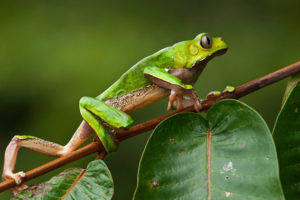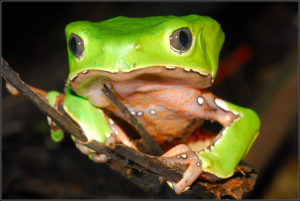- Depression and Anxiety
- Unhealthy Habits/Addiction
- Chronic Pain
- GI Imbalance/Gut Dysbiosis
- Fertility Problems
- Lyme Disease
- Joint issues/ Arthritis
- Immune System Disorders including HIV
- High Blood Pressure
- Prostate Cancer
- Heavy Metal Toxicity
- PTSD and Trauma Release
- Difficulty Making Big Life Decisions
- …so much more
What is Kambo?
What happens during a Kambo Treatment?

The Science of Kambô.
The scientific name of the Giant Monkey Tree Frog is Phyllomedusa bicolor, meaning “two-colored leaf guardian”.
Italian scientist and Nobel prize nominee, Vittorio Erspamer of the University of Rome was the first person to analyze Kambo in a laboratory. In 1986, he wrote that Kambo contained a “fantastic chemical cocktail with potential medical applications, unequaled by any other amphibian”. The chemicals that he referred to are peptides – short chain amino acids that make up proteins in our body. Pharmaceutical companies are working to study, synthesize, and profit from the unique peptides naturally found in Kambô. There are currently more than 70 Kambô patents pending, mostly in the United States.
Some peptides specifically affect brain activity and neuronal communication throughout the body. These special peptides are called neuropeptides. Examples of neuropeptides we naturally make in our bodies are endorphins (pain reduction and pleasure response hormones) , oxytocin (the “bonding” hormone) and insulin (blood sugar regulation).
Other peptides found in kambo are bioactive, composed of a specific chain of amino acids which perform a function that the body recognizes as beneficial. The body opens to kambo at a cellular level, allowing it to clean out deposits left in the cells by foreign substances with no stress to the cells. This combination of peptides is a unique key that unlocks the body, allowing kambo cross the blood-brain barrier rather than being filtered out by the body’s defense system. This makes kambo an extremely powerful way to reach and treat disease.
Kambo peptides include:
Dermorphin – Dermorphin has an opiate like effect on mu-opioid receptors, making it a very potent painkiller with effects 30-40 times stronger than morphine.
Deltorphin – Deltorphin is also a powerful painkiller and delta opioid agonist.
Phyllomedusin – A neuropeptide (possible to link to wikipedia page on neuropeptides?) that has a powerful effect on intestines and bowels, contributing to the purging often experienced when taking kambo.
Phyllokinin – This neuropeptide can cause a long lasting reduction in blood pressure.
Phyllocaerulein – Another potent painkiller that reduces blood pressure and affects thermoregulation.
Adenoregulin – A 33 amino acid peptide that works with the adenosine receptor. This antibiotic peptide can reduce the harmful effects of bacteria, fungi, and protozoa, including cancer cells.
Dermaseptin – Shows powerful antimicrobial activity against bacteria, yeast, fungi, protozoa, and enveloped viruses that often cause severe opportunistic infections.
Tryptophyllins – Highly potent against the yeast candida, may have potential in cardiovascular, inflammatory, and anticancer therapy.
Peptides Found in Phyllomedusa Frogs (2010)
Deltorphin Transport Across Blood-Brain Barrier (1997)
Dermaseptine (Antiviral Peptide?)
The Spirit of Kambô.
The most prevalent legend regarding the origins of Kambo comes from the Kaxinawa tribe in Brazil.
 The people of the forest had fallen ill and their shaman, a man known as Kampum, took sacred plant medicine to enter a trance and communicate with the spirits of the forest. He was contacted by a feminine spirit who presented him with a frog and taught him how to use its medicine to heal his village. When Kampum came to he brought this frog medicine to his people and was able to cure them. When Kampum passed years later his spirit passed into the the spirit of the frog, which became known as kambô.
The people of the forest had fallen ill and their shaman, a man known as Kampum, took sacred plant medicine to enter a trance and communicate with the spirits of the forest. He was contacted by a feminine spirit who presented him with a frog and taught him how to use its medicine to heal his village. When Kampum came to he brought this frog medicine to his people and was able to cure them. When Kampum passed years later his spirit passed into the the spirit of the frog, which became known as kambô.
For thousands of years the practice of kambo stayed in the forest, it was not until the 1990s that half-indigenous rubber tappers known as the Cobocla people learned the practice from the natives and began to take it to cities in Brazil. From there use of Kambô has slowly spread all over the world, gaining massive momentum in the past ten years. There is a shift occurring, more and more people are seeking alternative paths to healing and looking for deeper connection with themselves and the world around them. Kambo is an important part of this shift.